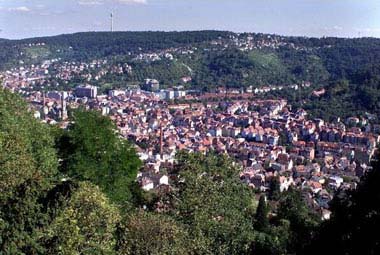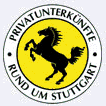
The district of Stuttgart-Süd (South) with Heslach and Kaltental, emerged as it is today in 1956 and is full of contrasts: Kaltental’s origins are in a small settlement which was part of the castle of the same name built in the early 12th century. The lords of Kaltental were at some time also burgraves in Stuttgart. The castle grounds were sold to Württemberg in 1318 and cleared away in the early 19th century because of disrepair. Only the old dairy-farm from 1551 still reminds of the castle on the site on which rises the Catholic St. Antonius church. Kaltental, suburbanised in 1922, is today shaped by well-groomed housing. Werner Veits song of "Anna Schäuffele from Kaltental" gives the yearly festival in Kaltental its name. Heslach on the other hand was never independent and was settled from Stuttgart as a suburb. Mentioned for the first time in the 14th century, the name Heslach comes from “Haselstrauch” (hazel bush) which could once be found on the banks of the Nesenbach. Agriculture together with wine growing and mills long dominated the scene until some large businesses settled here at the end of the 19th century such as the tricot factory Benger, the camera factory Contessa or the brewery Stuttgarter Hofbräu. Above all, Heslach however became the worker’s residential area. Due to the 25th anniversary of King Karl, it temporarily took on the name “Karlsvorstadt” from 1889. Worth seeing are the Alte Feuerwehrhaus, the Matthäuskirche, the Generationenhaus Heslach of the Rudolf Schmid and Hermann Schmid Stiftung and the cemetery with the Benckendorff-Kapelle. A highlight every year is the Heslacher Hocketse taking place since 1973, the oldest Stuttgart street festival for which the term "Hocketse" was once invented. At the end of the 19th century the development of the city towards the South had closed the gaps of remaining building land in Heslach. There are tall rental apartments opposite bourgeois housing and villas. Green stretches form he Karlshöhe with the Villa Gemmingen and the civic Lapidarium, the Weißenburgpark with the Teehaus, as well as the Fangensbachfriedhof with its old tombstones and the Art Nouveau Markuskirche. While the Nesenbach stream is mainly underground, stretching for 4.5 km across the district, the main road Nr.14 fortunately runs through a tunnel for most of its length. In contrast to the new roads, the Alte Weinsteige is an important transport link to Tübingen since the 14th century. In the early 19th century, this link was replaced by the Neue Weinsteige built by Etzel.







